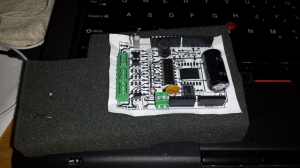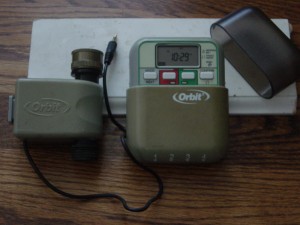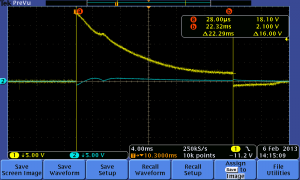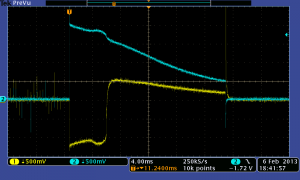Recently we found ourselves regretting a decision we made when we installed Ubuntu Server 12.04LTS on a VMware ESXi virtual machine (VM) — when we created the VM, we allocated a very small hard disk (8 GBytes) thinking that for the specific purpose of that machine we were not going to need a bigger hard drive. It turns out that we were very wrong, which became apparent when we tried to download a 4+ GByte file and the download failed because of lack of free space.
Because we did not want to create a new VM and copy the existing installation over we decided to just increase the size of the existing disk and the partitions/physical volumes/logical volumes inside it. Turns out this was not as easy as we thought so we decided to document things here. We basically followed the instructions in this blog post (credit where credit is due):
http://www.joomlaworks.net/blog/item/168-resizing-the-disk-space-on-ubuntu-server-vms
Increasing the size of the actual hard disk is very easy because we are working with a virtual machine — all it takes is to is to edit the virtual machine settings, look for the virtual disk, and increase the size (we have done this for both VMware and VirtualBox virtual machines; the process is similar). The difficult part comes after increasing the size of the virtual disk — the existing stuff inside the hard disk needs to be resized as well.
Several links we found online talked about booting the machine with an Ubuntu LiveCD and then using GParted (a GUI-based partition utility) to resize the existing partition to make use of the new, extra unallocated space. We did not have any luck with that.
Instead, what we found worked for us was to just make use of the Linux Logical Volume Manager (LVM), which is what was set up by the Ubuntu installer when we first installed Ubuntu on this machine. Basically, the process looks like this:
- Create a new logical partition using the new unallocated space.
- Create a new physical volume that uses the new partition.
- Extend the existing Volume Group that was created during Ubuntu installation to make use of the new physical volume.
- Extend the Logical Volume to make use of the new available space.
- Resize the filesystem to make use of the new available space.
We will go in detail on each of these steps.
Create New Logical Partition
We used cfdisk. Basically, select the unallocated (free) space, then select the “New” option, then “Logical”, and allocate all the available space (shown by default). Select “Type” and enter “8e” (for Linux LVM). Finally select “Write”, confirm by typing “yes” followed by <Enter>, then “Quit”, and reboot the machine.
This is how the partition table looked before using cfdisk:
root@holyland:~# fdisk -l /dev/sda
Disk /dev/sda: 268.4 GB, 268435456000 bytes
255 heads, 63 sectors/track, 32635 cylinders, total 524288000 sectors
Units = sectors of 1 * 512 = 512 bytes
Sector size (logical/physical): 512 bytes / 512 bytes
I/O size (minimum/optimal): 512 bytes / 512 bytes
Disk identifier: 0x0009f8ab
Device Boot Start End Blocks Id System
/dev/sda1 * 2048 499711 248832 83 Linux
/dev/sda2 501758 16775167 8136705 5 Extended
/dev/sda5 501760 16775167 8136704 8e Linux LVM
And this is how the partition table looks like after using cfdisk to create the new partition on the free space and rebooting the machine. Note the new partition /dev/sda6:
root@holyland:~# fdisk -l /dev/sda
Disk /dev/sda: 268.4 GB, 268435456000 bytes
255 heads, 63 sectors/track, 32635 cylinders, total 524288000 sectors
Units = sectors of 1 * 512 = 512 bytes
Sector size (logical/physical): 512 bytes / 512 bytes
I/O size (minimum/optimal): 512 bytes / 512 bytes
Disk identifier: 0x0009f8ab
Device Boot Start End Blocks Id System
/dev/sda1 * 2048 499711 248832 83 Linux
/dev/sda2 501758 524287999 261893121 5 Extended
/dev/sda5 501760 16775167 8136704 8e Linux LVM
/dev/sda6 16775231 524287999 253756384+ 8e Linux LVM
Create New Physical Volume
To create a new physical volume in the new partition we used pvcreate:
root@holyland:~# pvcreate /dev/sda6
Physical volume "/dev/sda6" successfully created
Extend Existing Volume Group
First, we need the name of the volume group. This can be obtained by running the vgdisplay command:
root@holyland:~# vgdisplay
--- Volume group ---
VG Name holyland
System ID
Format lvm2
Metadata Areas 1
Metadata Sequence No 3
VG Access read/write
VG Status resizable
MAX LV 0
Cur LV 2
Open LV 2
Max PV 0
Cur PV 1
Act PV 1
VG Size 7.76 GiB
PE Size 4.00 MiB
Total PE 1986
Alloc PE / Size 1978 / 7.73 GiB
Free PE / Size 8 / 32.00 MiB
VG UUID H5FfHu-lsxo-G9Od-k8S5-lnCQ-PuCq-059Xco
The output above (under “VG Name”) shows that the name of the volume group is “holyland” (the name of our server).
Next we use the vgextend command to extend the existing volume group to the new physical volume:
root@holyland:~# vgextend holyland /dev/sda6
Volume group "holyland" successfully extended
Extend The Logical Volume
First, we need to obtain the name of the logical volume that we want to extend (this is because a volume group can contain several logical volumes). To obtain the name of the logical volume with use the lvdisplay command:
root@holyland:~# lvdisplay
--- Logical volume ---
LV Name /dev/holyland/root
VG Name holyland
LV UUID vNPQV1-s5OU-GYVP-FCMp-p3UY-7fhe-FXNsK8
LV Write Access read/write
LV Status available
# open 1
LV Size 7.23 GiB
Current LE 1851
Segments 1
Allocation inherit
Read ahead sectors auto
- currently set to 256
Block device 252:0
--- Logical volume ---
LV Name /dev/holyland/swap_1
VG Name holyland
LV UUID YxBsBD-we0S-ELCV-yCsz-RAdL-Qzcj-y4cpH9
LV Write Access read/write
LV Status available
# open 2
LV Size 508.00 MiB
Current LE 127
Segments 1
Allocation inherit
Read ahead sectors auto
- currently set to 256
Block device 252:1
We are interested in extending the logical volume used for the root filesystem, which corresponds to the logical volume called “/dev/holyland/root” in the output above (under “LV Name”).
To extend the logical volume we are interested in, we use the lvextend command as follows:
root@holyland:~# lvextend -l 100%FREE /dev/holyland/root
Extending logical volume root to 242.03 GiB
Logical volume root successfully resized
Note the use of of the “-l 100%FREE” argument, which indicates that we want to extend the logical volume to use 100% of the free space.
Extend Filesystem
Finally, to extend the file system we use the resize2fs command:
root@holyland:~# resize2fs /dev/holyland/root
resize2fs 1.42 (29-Nov-2011)
Filesystem at /dev/holyland/root is mounted on /; on-line resizing required
old_desc_blocks = 1, new_desc_blocks = 16
The filesystem on /dev/holyland/root is now 63447040 blocks long.
To verify, we use the df command:
root@holyland:~# df -hT
Filesystem Type Size Used Avail Use% Mounted on
/dev/mapper/holyland-root ext4 239G 3.8G 225G 2% /
udev devtmpfs 237M 4.0K 237M 1% /dev
tmpfs tmpfs 99M 260K 98M 1% /run
none tmpfs 5.0M 0 5.0M 0% /run/lock
none tmpfs 246M 0 246M 0% /run/shm
/dev/sda1 ext2 228M 75M 141M 35% /boot
Now the root filesystem has a healthy size!




